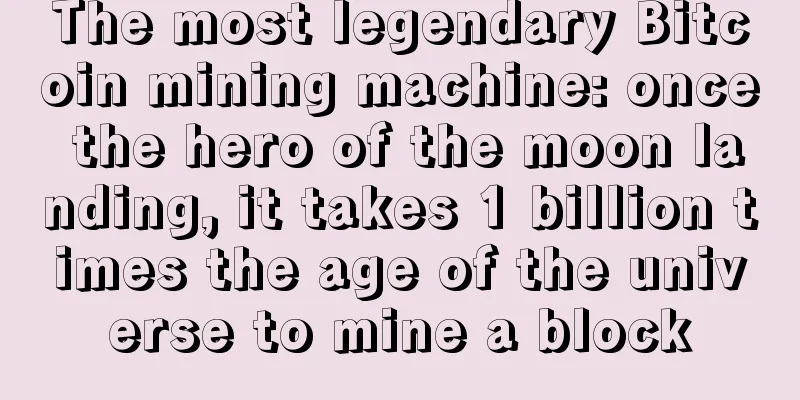The most legendary Bitcoin mining machine: once the hero of the moon landing, it takes 1 billion times the age of the universe to mine a block

|
Some people are so obsessed with the word “can” that they never think about the word “should.” Recently, one person has converted the Apollo space mission guidance computer (AGC) into a Bitcoin mining machine. Image source: pixabay Bitcoin mining machine that landed on the moonKen Shirriff is a man with a passion for restoring vintage computer hardware. For his latest project, Shirriff got a guidance computer from an Apollo space mission and made it work again; in his opinion, it's the only example of a workable system. This computer was small enough to fit on the actual Apollo spacecraft, even though most computers used during the Apollo moon landings ranged in size from refrigerators to entire rooms. Of course, once you have such a machine, you should give it something to do. After all, there aren't that many moon landings to give it direction. But what function does it have? In Shirriff’s own words: “Trying to mine Bitcoin on this 1960s computer seemed both pointless and anachronistic, so I had to give it a try.” As you might have guessed, implementing the SHA-256 hashing algorithm on this 15-bit machine is difficult. However, Shirriff succeeded, as shown in the video below. As you can imagine, this machine is far from the fastest mining machine. One SHA-256 hash takes 5.15 seconds, and since Bitcoin uses double hashing, it works out to just under 0.01 hashes per second. At this rate, Shirriff calculated that it would take about 1 billion times the age of the universe to mine a single Bitcoin block. However, this is not the slowest method of bitcoin mining he has tried. His previous projects have included mining using an old punch card computer system and even mining a block by hand. In comparison, the punch card experiment was able to calculate one Bitcoin hash in 80 seconds, while the rate of calculating hashes using pencil and paper was 0.67 per day. Obviously, none of this will make Shirriff a Bitcoin millionaire. But he should be applauded for his commitment to preserving computing technology from the past. Let’s just hope he doesn’t convert any more Apollo guidance computers into mining rigs. Or maybe Cambridge University’s project to calculate the real-time Bitcoin network’s energy requirements will have to recalibrate its worst-case efficiency scenarios. |
<<: The battle for high-performance mining machines
Recommend
Analysis of nasolabial folds: different shapes and different destinies
1. Eight-shaped nasolabial folds The nasolabial f...
If you have a tear mole and he has a bitterness mole, please stay together forever
Tear mole and bitter mole, just hearing the names...
Exclusive interview with F2Pool CMO Qingqing: Miners’ interests come first
On December 20, the "2019 Digital Mining Sum...
Elliptic receives $5 million in funding, illegal Bitcoin transactions may face a nemesis
Elliptic, a UK-based startup that monitors bitcoi...
Is a man with high cheekbones destined to have a good fate? What does a man with high cheekbones mean?
Men with high cheekbones have bad luck with noble...
Do men with heavy bags under their eyes have good fortunes and are they blessed in their lives?
Eyes are one of the most important facial feature...
There is no destiny line on the left palm of a man
There are countless lines in our palms, and many ...
More selfish, only care about your appearance first
Some people tend to be very selfish. They always ...
Are you one of those people who can't stay in any job for long?
In the workplace, there is a type of person who i...
Different parts of the face reveal the fortune of relatives
Different parts of the face reveal the fortune of...
What are we talking about when we talk about Bitcoin?
Author: Velvet Gold Mine As long as a system requ...
Security pioneer McAfee appoints blockchain expert to improve digital currency and blockchain security
Security pioneer John McAffee has added two bitco...
What is the difference between a bulbous nose and a hanging nose?
Some noses are very slightly different. If you do...
What are the facial features of a money-scattering nose? Do you have it?
In physiognomy, the nose is related to our fortun...
Is it a bear market now? Listen to the researcher's analysis of the current market situation
By Dylan LeClair, 21st Paradigm Lianchuang Compil...









